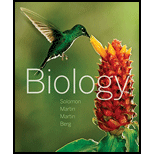
Concept explainers
During signal transduction (a) the cell converts an extracellular signal into an intracellular signal that leads to a change in some cell process (b) a signaling molecule directly activates or represses several genes (c) each enzyme catalyzes production of one molecule of product (d) enzymes in the signal cascade remain active until the last component of the pathway alters a cellular process (e) the signal is terminated by cyclic AMP
Introduction: There are four sequences of events that take place in cell signaling. These are signal transmission, reception, signal transduction, and response. In signal transduction, the cell changes the extracellular signals into intracellular signals. Cell generates a number of internal molecules that work in a specific manner.
Answer to Problem 1TYU
Correct answer: Signal transduction is a process in which extracellular signals get converted into intracellular signals. Hence the correct answer is option (a).
Explanation of Solution
Reason for the correct answer:
Option (a) is given as “the cell converts an extracellular signal into an intracellular signal that leads to a change in some cell process”. In signal transduction, the cell changes the received extracellular signals into intracellular signals. Cell generates a number of internal molecules that work in a specific manner to cause a response. It may either activates genes or deactivate it.
Hence the correct answer is option (a).
Reasons for incorrect answers:
Option (b) is given as, “a signaling molecule directly activates or represses several genes”. A signaling molecule activates several downstream molecules which either activate or deactivates the genes. This is not part of signal transduction event. Hence, option (b) is incorrect.
Option (c) is given as, “each enzyme catalyzes production of one molecule of product”. The signal get amplified at each downstream of the pathway in which an enzyme catalyzes several other molecules. This is not part of signal transduction event. Hence, option (c) is incorrect.
Option (d) is given as, “enzymes in the signal cascade remain active until the last component of the pathway alters a cellular process”. Enzyme in the signal cascade gets inactivated once it activates the downstream molecules. It does not remain active until the last component for the pathway alters the process. This is not part of signal transduction event. Hence, option (d) is incorrect.
Option (e) is given as, “the signal is terminated by cyclic AMP”. Cyclic AMP is an effector molecule. It does not terminate the signal. The signal is terminated by phosphodiesterase which inactivates the cyclic AMP to AMP or phosphatase which inactivates the protein by removing phosphate group. This is not part of signal transduction event.
Hence, option (e) is incorrect.
Hence the options (b), (c), (d), and (e) are incorrect.
Signal transduction is a process in which extracellular signals get converted into intracellular signals which causes changes in cell processes.
Want to see more full solutions like this?
Chapter 6 Solutions
Biology (MindTap Course List)
- Explain in a small summary how: What genetic information can be obtained from a Punnet square? What genetic information cannot be determined from a Punnet square? Why might a Punnet Square be beneficial to understanding genetics/inheritance?arrow_forwardIn a small summary write down:arrow_forwardNot part of a graded assignment, from a past midtermarrow_forward
- Noggin mutation: The mouse, one of the phenotypic consequences of Noggin mutationis mispatterning of the spinal cord, in the posterior region of the mouse embryo, suchthat in the hindlimb region the more ventral fates are lost, and the dorsal Pax3 domain isexpanded. (this experiment is not in the lectures).a. Hypothesis for why: What would be your hypothesis for why the ventral fatesare lost and dorsal fates expanded? Include in your answer the words notochord,BMP, SHH and either (or both of) surface ectoderm or lateral plate mesodermarrow_forwardNot part of a graded assignment, from a past midtermarrow_forwardNot part of a graded assignment, from a past midtermarrow_forward
 Biology (MindTap Course List)BiologyISBN:9781337392938Author:Eldra Solomon, Charles Martin, Diana W. Martin, Linda R. BergPublisher:Cengage Learning
Biology (MindTap Course List)BiologyISBN:9781337392938Author:Eldra Solomon, Charles Martin, Diana W. Martin, Linda R. BergPublisher:Cengage Learning Human Physiology: From Cells to Systems (MindTap ...BiologyISBN:9781285866932Author:Lauralee SherwoodPublisher:Cengage Learning
Human Physiology: From Cells to Systems (MindTap ...BiologyISBN:9781285866932Author:Lauralee SherwoodPublisher:Cengage Learning Human Biology (MindTap Course List)BiologyISBN:9781305112100Author:Cecie Starr, Beverly McMillanPublisher:Cengage Learning
Human Biology (MindTap Course List)BiologyISBN:9781305112100Author:Cecie Starr, Beverly McMillanPublisher:Cengage Learning Biology: The Dynamic Science (MindTap Course List)BiologyISBN:9781305389892Author:Peter J. Russell, Paul E. Hertz, Beverly McMillanPublisher:Cengage Learning
Biology: The Dynamic Science (MindTap Course List)BiologyISBN:9781305389892Author:Peter J. Russell, Paul E. Hertz, Beverly McMillanPublisher:Cengage Learning Biology 2eBiologyISBN:9781947172517Author:Matthew Douglas, Jung Choi, Mary Ann ClarkPublisher:OpenStax
Biology 2eBiologyISBN:9781947172517Author:Matthew Douglas, Jung Choi, Mary Ann ClarkPublisher:OpenStax BiochemistryBiochemistryISBN:9781305577206Author:Reginald H. Garrett, Charles M. GrishamPublisher:Cengage Learning
BiochemistryBiochemistryISBN:9781305577206Author:Reginald H. Garrett, Charles M. GrishamPublisher:Cengage Learning





